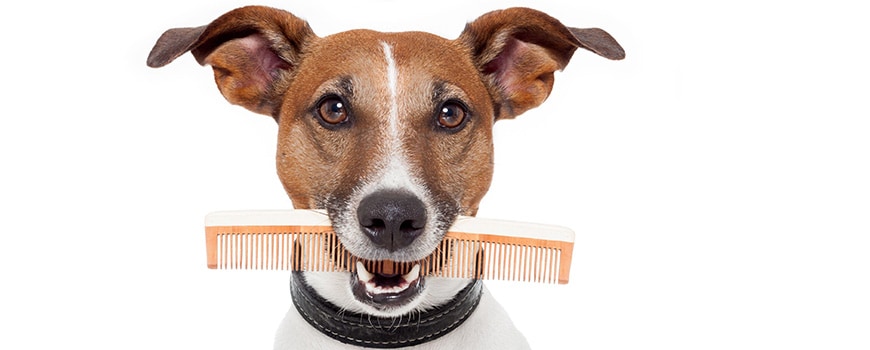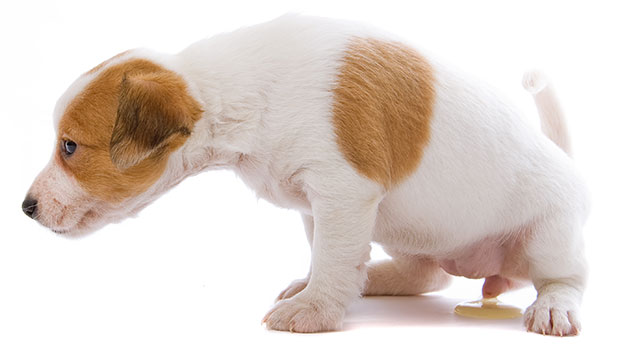Signs of urinary tract disorder in your dog can be the followings:
- Squatting or cocking leg frequently but passing only a few drops of urine
- Frequently passing a large volume of urine
- Change in color of urine from normal pale yellow
- Abdominal pain
- Increased thirst, drinking more than 1.6 oz of water per pound of body weight over a 24 hour period. This is easy to measure if your dog is the only household pet and not drinking from an outside water source such as a pond.
Urinary tract disorder will rapidly affect your dog’s general health and need fast diagnosis. Look out for any change in his normal intake of water and output of urine, because this could be an early warning sign.
Cystitis in Dogs
Bladder infections (cystitis) tend to be more common in females, because the female urethra, the tube that carries urine from the bladder, is shorter than in male dogs, making it easier for bacteria to enter the body.
A dog with cystitis may repeatedly pass only a small amount of urine, which may contain blood and look pink.
If you can collect a urine sample it will help diagnosis; otherwise, your vet may take a sample directly from the bladder. If infection is present, the vet will prescribe an appropriate antibiotic.
It is important to find any underlying cause for cystitis. For example, glucose in the urine associated with diabetes mellitus can increase susceptibility to bladder infections.
A less common cause of bladder infection is a growth in the bladder wall. This may be detected by your vet palpating your dog’s bladder, or during a bladder scan.
Urinary Stones
Cystitis  may also be associated with the presence of crystals in the urine, which can be seen under a microscope. A further complication is that urinary crystals can form into stones in the bladder. Your vet may be able to feel the stones manually and they can also be picked up by X-ray or an ultrasound scan.
may also be associated with the presence of crystals in the urine, which can be seen under a microscope. A further complication is that urinary crystals can form into stones in the bladder. Your vet may be able to feel the stones manually and they can also be picked up by X-ray or an ultrasound scan.
Some bladder stones can be dissolved with medication, but other types have to be removed surgically. Extracted stones are analyzed in a laboratory to determine how to prevent further stones from forming.
If a stone passes from the bladder, a male dog’s urethra may become blocked because it is a long and narrow tube (unlike a female’s urethra, which is short and wide).
This situation requires urgent veterinary attention. Not only is the condition extremely painful, but it prevents the passage of urine out of the bladder, leading to pressure backing up to the kidneys and damaging them.
Prostatic Disease
The prostate, the sex gland lying around the urethra of the male dog, is prone to various disorders. Bacterial infection ascending from the urethra can cause swelling and inflammation of the prostate.
Symptoms may include blood dripping from the penis, urinary incontinence or difficulty passing urine, abdominal pain, and straining to pass feces. Infection is treated with antibiotics and castration.
Swelling can also be caused by benign prostatic enlargement, which occurs in an unneutered dog and is treated by castration. Rarely, prostate enlargement is due to a tumor, especially in castrated dogs.
Urinary Incontinence
It is important to differentiate between a house-training lapse, when your dog consciously empties his bladder but just cannot get outside in time, and incontinence, where urine leaks out when your dog is relaxed or asleep.
In a puppy, incontinence may be due to a congenital anatomical problem, for which surgical treatment may be possible. Some dogs may become incontinent after neutering, and some require long-term medication.
Incontinence in old age can also be controlled medically to some extent. Your vet will want to check that there is no underlying disease.
Kidney Disease
The kidneys – which filter waste from the blood – are susceptible to infection and can be affected by some inherited diseases.
Kidney failure is common in old dogs. Signs of disease include increased thirst and urination with weight loss, poor appetite, and vomiting developing later. Urine and blood tests help identify the cause.
Urine Testing
A useful specimen to take to the vet is a sample of the first urine your dog passes in the morning. Use a resealable container and be prepared to move quicly to catch the stream as your pet squats or cocks a leg. Your vet can provide a ” collection kit ” to make it easier.


